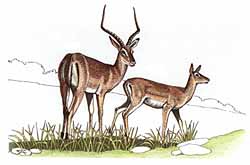English: Impala; French: Impala; Afrikaans: Rooibok; Damara: arab; Iswana: Chala; Kikuyu: Ndaratari; Kirundi: Impala, Impala; Kiswahili: Swala, Pala; Kung: Kxara; Kwanyama: Omhala; Lozi: Pala; Maasai: Entarukuet; Nganguela: Mpala; Ndorobo: Tewereta; Shangan: Mhara; Sindebele: Mpala; Sotho: Phala; Tswana: Phala; Zulu: Impala
 |
Former distribution: From Kenya and Uganda south to the Cape and north to northern Namibia, Botswana and southern Angola.
Present distribution: Rwanda, north-east Uganda, central and southern Kenya, south-eastern Zaire, Tanzania, Zambia, central and southern Malawi, Zimbabwe, Mozambique, and in South Africa – Natal, Transvaal; northern Cape, eastern and northern Botswana, Caprivi-Strip and Ovamboland in Namibia, south-western and south-eastern Angola.
Behaviour: Preferred habitat: open savanna, deciduous woodlands in both low and hilly regions – always in the vicinity of water: gregarious and form herds of up to 50 and more: active at twilight; diet consists of grass, bushes, flowers and fruits. Predators include lions, leopards, cheetahs, wild dogs, hyenas and crocodiles.
Population status: In most areas stable. Endangered in Angola, and rare in Namibia.
Brief notes:
Body weight: 60-80 kg
Head and body length: 130-160 cm
Tail length: 30-45 cm
Shoulder height: 80-95 cm
Gestation period: 6 1/3-7 months
Maximum age: 12 years (15 years in captivity)
Trophy: Record (Aepyceros m. melampus) SCI: 65 5/8 score, 1969 RSA, FRANK MARCHETTI; average 54 score. RW’s: 31 7/8″, 1946 RSA, J.V. EDGAR-JONES; average 22″.
Hunting methods: Stalking.
Subspecies: 6. Here only 3 are listed – descriptions of the others are unclear.
1. Southern Impala Aepyceros m. melampus Zimbabwe, Zambia, south-eastern Zaire, Mozambique, southern Malawi, southern Tanzania, Botswana and Caprivi-Strip in Namibia and northern South Africa. Stable; rare in Nambia.
2. Angola Impala or Black-faced Impala Aepyceros m. petersi South-west Angola, Ovamboland in Namibia. Endangered in Angola and rare in Namibia. Estimated numbers: 1000 in Namibia. Angola: No records. Trophy: Record SCI: 59 2/8 score, 1984 Namibia, MARVIN D. HILL jr.; average 50 score. RW’s: 26 1/2″, 1957 Angola, H. DE C. ESPINHA; average 21″.
3. East African Impala Aepyceros m. rendilis Tanzania, Uganda and Kenya, Rwanda. Stable. Trophy: Record SCI: 75 4/8 score, 1983 Tanzania, THORNTON N. SNIDER; average 60 score. RW’s: 36 1/8″, 1937 Kenya, COUNT G. AHLEFELDTBILLE; average 27″.
Remarks: As noted above, subspecies A.m. suarae (Kenya), A.m. johnstoni (Malawi and northern Zambia and southern Tanzania), A.m. katangae (Zaire) are omitted here. The Angola Impala, A.m. petersi is smaller in body and horns than A.m. melampus and A.m. redilis; typical also is the black face of this Angolan Impala. They were successfully introduced into private farms in Namibia and South Africa. The war in Angola may lead to total extinction.






